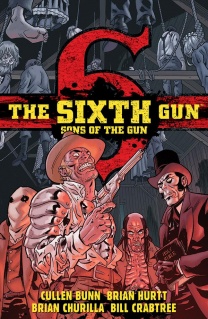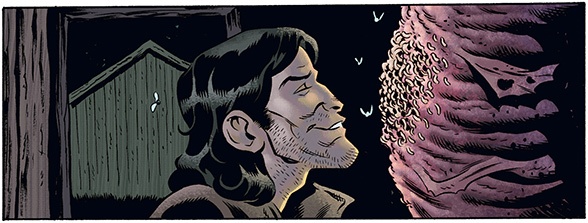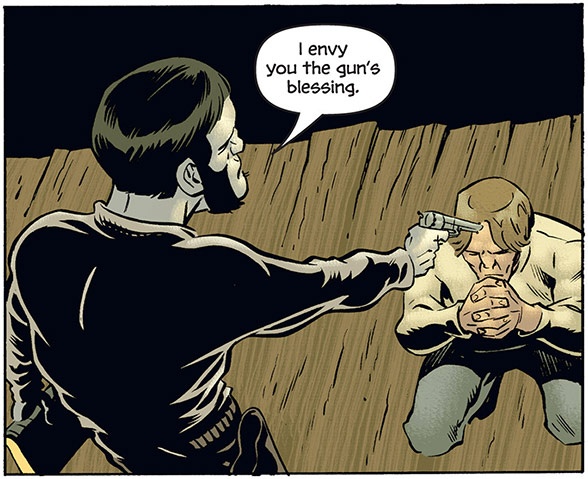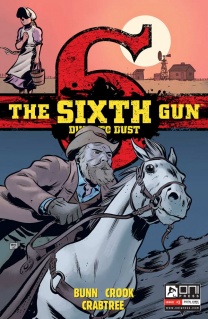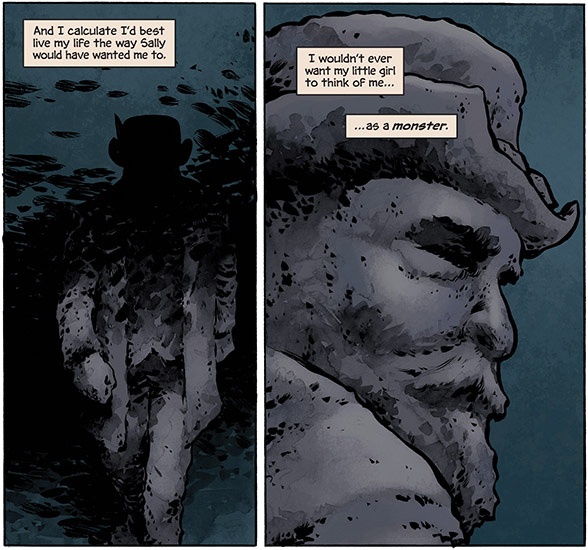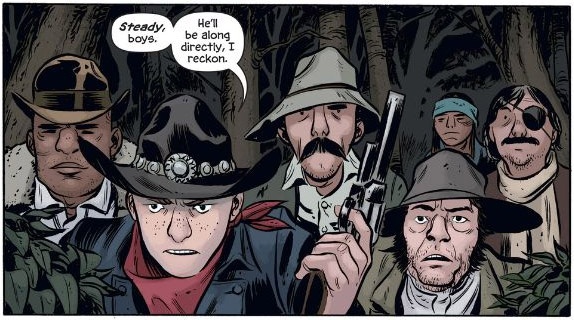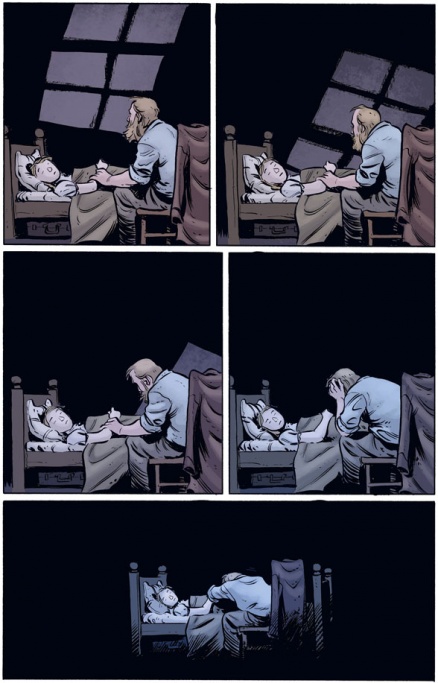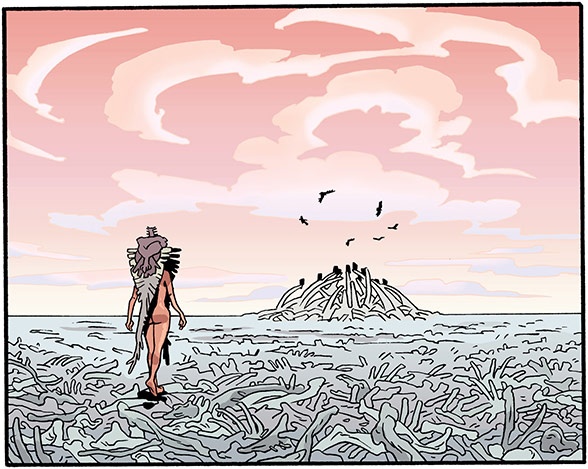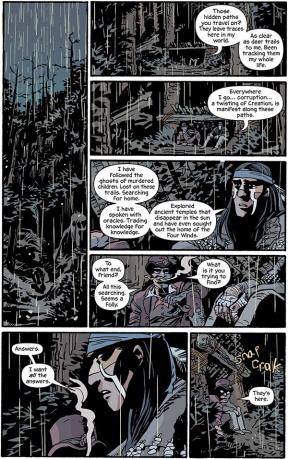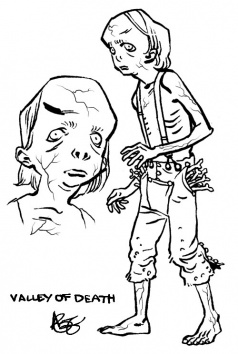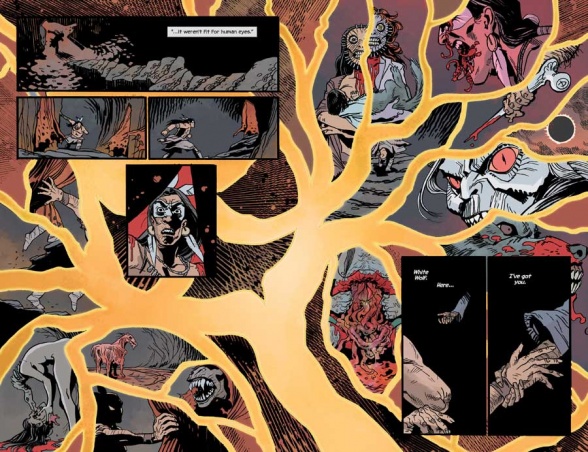
After six years, “The Sixth Gun” is coming to an end. To mark the occasion, Haunted Trails is looking back at this journey we’ve taken. Six guns, six interviews.
In the fourth interview, Cullen Bunn and Brian Hurtt are joined by Brian Churilla, Mike Norton, Tyler Crook, and A.C. Zamudio, the various artists from the spin-off titles, “Sons of the Gun”, “Days of the Dead”, “Dust to Dust”, and “Valley of Death”.
If you missed the previous interviews, you can find them here:
1. “Cold Dead Fingers” and “Crossroads”
2. “Bound” and “A Town Called Penance”
3. “Winter Wolves” and “Ghost Dance”
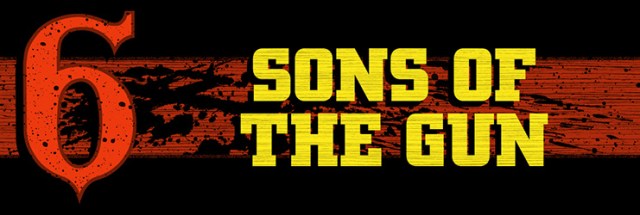
In 2013, Brian Hurtt took on writing duties alongside Cullen Bunn for “Sons of the Gun”, a five-issue miniseries drawn by Brian Churilla and colored by Bill Crabtree. The miniseries explores General Hume’s four horsemen—Bill Sumter, Ben Kinney, Will Arcene, and Silas Hedgepeth—in the years after the Civil War, before the opening pages of “The Sixth Gun” #1.
From what I hear, Cullen Bunn had been wanting to work with you ever since “The Tooth”. How’d you first become involved with the series?
Brian Churilla: I’d wrapped on “The Secret History of D.B. Cooper” and Oni approached me about “Sons of the Gun”. I’d been wanting to work with Cullen as well, so it was a no-brainer for me. He’s a great storyteller, and I’d been wanting to work with him for a really long time.
Brian Hurtt: When Cullen and I started to hash out this story we had to also think in terms of who we might get to draw it. As you stated, Brian was someone that Cullen wanted to work with but he was also someone that I wanted to work with as I was a big fan of his “The Secret History of D.B. Cooper”. As we made our lists we both found that Brian was at the top of them. We were really excited when we reached out and he agreed to do the series.
Cullen Bunn: I tell you, working with Hurtt to find an artist to work on the series was an interesting project. We discussed a lot of talented artists, but it was important to find someone who complemented the work Brian had been doing in the main series.
In the ongoing “Sixth Gun” story, Becky and Drake have had the guns for about a year, and we can see already how adversely it’s affecting them in such a relatively short time. The four horsemen had theirs far longer—since the Civil War, long enough for Becky to have grown from a child to adult—so they’re really the best examples readers have for how how the guns affect body, mind, and soul.
‘Bloodthirsty’ Bill Sumter may have been a cold-blooded killer, but even he was disturbed by his gun’s thirst for death, to the point that he stopped using it. But it wore him down, until it became too hard to resist anymore, and when to took his gun up again, he became even more a monster than he ever was. For me that’s the heart of this story, each of the four horsemen have a line they don’t want to cross or some part of themself they want to hold on to, but then their guns break them.
Brian C., you had to find the human in each of these monstrous characters, character that are the embodiment of War, Famine, Pestilence, and Death. How did you approach that challenge?
Brian C.: Brian Hurtt had really established the overall look of the characters, so I was really following his lead, and I definitely tried to stay faithful to what they had established early on. Cullen wrote compelling stories that showed the four horsemen’s humanity. It was an easy thing to do, given the nature of their individual histories.
Ben Kinney’s story really demonstrated the physical change wrought by the guns. His whole body is covered in diseased blisters, and it cuts him off from the world. In the end, he even killed the woman he professed to love, and he felt justified in doing so. I find it interesting that throughout all of this, you never showed his face, just his eyes. What’s the reasoning behind that?
Continued belowBrian C.: I think that was at the suggestion of Cullen, because we never really see his face before that, so he wanted to maintain that mystery.
Cullen: Yeah, no matter what, Ben’s face remains a mystery, much like Snake Eyes!
Brian H.: This was my favorite issue of this miniseries. I just love the character of ‘Filthy’ Ben Kinney. The story plays out as a tragedy and you do feel sympathy for the character, but in the end he is unable to escape the pull of darkness.
I felt like the darkness of this issue and the following one played especially well to Churilla’s strengths and his style with its heavy blacks.
I found Will Arcene’s story rather surprising, that he was the son of a demon. Did Cullen and Brian H. talk to you about where the line was between his urges as a demon spawn versus his urges brought on by possessing the Second Gun?
Brian C.: I think that was conveyed and directed in the script. They planned this thing out very well, and I was there to execute to the best of my abilities.
Silas Hedgepeth actually sought out redemption for himself, and it was shocking to see how the Fourth Gun distorted and perverted his actions. The others know what they’re doing is wrong, but Silas actually thinks he’s doing some good. Unlike the others, he doesn’t have a ‘Screw it, I’m evil now’ moment. How did deal with that disconnect in the character, where his intentions are so out of tune with his actions?
Brian C.: That was all pretty intuitive and nuanced. I tried to show that duality in subtle ways.
Which of General Hume’s four horsemen did you enjoy drawing the most?
Brian C.: First of all, I really loved working on these characters. Hurtt did a great job designing them, but out of all of them, I really like Bill. He’s a very iconic, compelling character for me. The armor, the scarred face, he’s just really cool and a lot of fun to draw.
Cullen, Brian H., what was this miniseries like for you both? How did it shake up your dynamic going from an artist and writer team to a pair of writers working with an artist for hire? And Brian, what was it like for you adapting to writing?
Cullen: We talked the series out quite a bit in the beginning, but the scripting played out a little different from issue to issue. For some, Brian took the lead. For others, I took the lead. There were some issues where each of us wrote a few pages, and others where one of of tackled the whole thing then passed it off to the other to polish off.
Brian H.: I remember that Cullen had a brief outline for the entire series. Each issue had just a few sentences that roughly sketched out the arc of that issue. Like Cullen said, we each had a different hand in every issue to varying degrees. There were a couple where I wrote the majority of the issue based on the outline with Cullen coming in and polishing it up a bit. Others were more of a back and forth. The only exception being issue #3 which Cullen wrote all on his own.
Even though it was the first time we had ever co-scripted anything it was actually a pretty seamless transition as it was really just an extension of the kind of collaboration we’ve been doing for years.
Brian Churilla is currently working on “Godzilla: Oblivion” with writer Joshua Hale Fialkov. You can follow him on Twitter here and check out his website here.

In 2014, Cullen Bunn and Brian Hurtt wrote “Days of the Dead”, a five-issue miniseries drawn by Mike Norton and colored by Bill Crabtree. The miniseries explores Brother Roberto Vargas and Jesup Sutter as they try to stop the spirit Yum-Kimil from taking over the world.

Mike Norton: I had a unique position of being a fan of the book before getting to work on it, so it was really fun to get to be part of this backstory that we all knew was there. So it was just as much a surprise to me getting to read the scripts!
For me, the thing that excited me most about this spin-off was learning more about Abigail Redmayne and what led Drake to kill her, a moment first teased in “The Sixth Gun” #20. What was it like for you getting to explore this moment, especially knowing readers’ expectations had been building up to it for a while?
Mike: It was very cool, because I had always wondered about it too. Cullen did a good job of hitting us with that panel way back and then letting the reader’s mind wander. I figured there was more to the story than what we saw, and well…
Brian H.: I’m going to let the cat out of the bag here… When Cullen wrote that flashback panel way back in “Sixth Gun” #20 he had no idea what the story there was! He just knew it was a compelling image and added some mystery to the relationship between Drake and Jesup. I think it was probably his intention to come back to it later in the series, but the problem became that the image was too compelling! We kept finding ourselves talking about what the story was there and really wanting to explore it a little more in depth. When we realized that we had the opportunity to explore some of these side stories in greater depth in the form of mini-series, this is the story that leapt out to us—demanding to be told.
As an aside, I just have to say that I loved the way Mike drew Abigail! She was so regal and beautiful! I was jealous of how pretty he could make her.
Cullen: Don’t spoil my secrets, Hurtt!
Mike, did you have much input on this story? Like was there something Cullen and Brian knew you wanted to draw that they worked into the script for you?
Mike: No. I was strictly drawing hands on this one, and I was fine with that. Like I said, I was a fan of the book before this. For me, it was like getting to watch a movie I’d been waiting for, only I get to draw it!
Either way, they got you to draw some crazy stuff. The reanimated corpses stitched together by Yum-Kimil in particular. Could you tell me about your design process for those?
Mike: Yeah, well… That’s how I PREFER it! I WANT to be surprised with what I have to draw when I read a script. Lots of great writers will ask you, ‘What do you want to draw?’ and I always tell them, ‘Surprise me!’
As for the corpse creatures… EEESH. Well, those things were described pretty thoroughly in the script. It was just a matter of creeping myself out after that.
Brian H.: When it came to those creatures, I remember that I did little sketch designs of them and then just described those sketches in the script. I’m not sure that I ever showed them to Mike though.
I really loved the way they were obviously human, and yet their silhouettes and movement were much more insect or arachnid-like.
And, Mike, you even got to show the face of death made flesh for a few frames. I have a feeling he’s a character we’ll be seeing again, so I’m curious, did you design him or did Brian Hurtt?
Mike: All Brian. He sent a couple of things along to help me get on the same page as him visually. I tried to draw him in the shadows as much as possible, though. Things without faces are creepier.
No kidding. It made my skin crawl when all you saw were his arms and that blood-covered needle and thread.
What was your favorite sequence to work on?
Mike: Anything with Roberto and his dad’s skull. I found those to be perfect for me. Simple character stuff, but still creepy and funny when you think about it. I loved drawing all of his scenes.
Continued belowBrian H.: As we were working on the script, I found myself really loving those scenes as well. I would have loved to see a whole series focused on Roberto and his dad’s head as they travel the country and have adventures!
Mike Norton is currently working on “B.P.R.D. Hell on Earth”. You can follow him on Twitter here and check out his website here.

In 2015, Cullen Bunn wrote “Dust to Dust”, a three-issue miniseries drawn by Tyler Crook and colored by Bill Crabtree. The miniseries explores Bunn’s favorite character, Billjohn O’Henry, as he faces the reality of death.
Tyler, technically this interview is supposed to be about all the “Sixth Gun” spin-offs, but you’ve also drawn three issues of the main series, so I hope you don’t mind if I ask you about those too. In particular, you drew the first appearance of the Grey Witch in the series during one of Asher Cobb’s visions, and then later you got to draw her backstory when she was still known as Griselda. In that story you got to show off the Great Wyrms too. For a guest artist, Cullen and Brian have entrusted you with some really mythology-heavy stories for the series. So what is it about you do think that makes them go ‘Yep, he’s the guy for the job’?
Tyler Crook: I don’t know why these guys trusted me to work on their book! I did the first fill-in issue right after I finished “Petrograd”. So I had a relationship with Oni and I had hung out with Cullen and Brian at conventions and stuff. I think they chose me because I was available and they liked my work. But really I don’t care why they picked me; I’m just glad they did choose me! I think “The Sixth Gun” is one of the coolest books that I’ve ever read and I really feel lucky to be a part of it in any way.
Brian H.: It’s been said many times by Cullen and I, but Tyler isn’t just one of the best comic artists out there he’s also just one of the best people out there.
I fell in love with his work when I would be in the Oni offices and see pages of “Petrograd” hanging above editor’s desks (this was a year or more before it was published). I knew right away that this guy was the real deal and was already conspiring to find a way to work with him. When Cullen and I discussed who we wanted to do the three guest artist issues (we always knew there were three) it was Tyler who was above and beyond the frontrunner. We couldn’t believe it when he said yes!
I love the visions in both “The Sixth Gun” #14 and “Dust to Dust”, and the painterly approach you took with them. I spoke to Cullen about “Dust to Dust” a little while back, and he mentioned how the story isn’t a flashback like the other spin-offs, but rather present-day Billjohn putting the pieces coming together, remembering this period of his life. Your ‘flashes of memory’ were a way to unsettle the story. Who’s idea was it to change the art style for the visions in these stories?
Tyler: I think it was my idea to to do the watercolor thing. I’m pretty much always looking for an excuse to use watercolor. Haha. It was an effect I had used for the visions in the Asher Cobb story so it seemed to make make sense to use something similar for this story too. One thing I was trying to do with them—and I don’t know how well this worked—was to make them come into tighter focus as the series progressed. So the the first time we see one of those memories it’s very abstract but by the time it we reach the end of the story the focus it quite tight and the drawings are much more refined.
This miniseries is a slight departure from the usual “Sixth Gun” tale. Instead of the customary narrator, this tale is told by Billjohn himself. Did this make you approach the storytelling any differently?
Continued belowTyler: I don’t think so. I feel like my approach to drawing comics fits very naturally with how Cullen writes comics. So I just do what I do. However, I feel like there was an emotional core to the “Dust to Dust” story that needed more attention than previous stories that I’d done.
Cullen: I think having Billjohn narrate the story changed some minor elements for me, because for the first time we’re seeing a story through Billjohn’s eyes. Some of the tonal differences in the series are because this story is seen through Billjohn’s eyes.
Kid Bedlam is a name that’s been drifting in and out of “The Sixth Gun” since the earliest issues, but until “Dust to Dust” we never got to meet him. Did you have fun playing with the Kid Bedlam in readers’ heads versus the reality of the character when we finally meet him?
Tyler: Haha! Yeah, It was cool to finally see that dude’s face. It was fun to draw him but mostly because he had a compelling emotional arc. He’s only around for like five pages but by the time he’s gone you are kind of rooting for him and his gang and you feel bad about how things turned out.
Cullen: Kid Bedlam is a character that’s been kicking around in my head for years and years, long before we used him in “The Sixth Gun”, so I wanted to make sure to give him a great scene when he finally made it to the page!
Brian H.: I just have to interject here, even though I had absolutely nothing to do with this story! That Kid Bedlam sequence that Tyler is referring to might be my favorite “Sixth Gun” scene. It may have something to do with not seeing any of it until it was drawn and lettered but I thought that sequence was quintessential “Sixth Gun”—it had humor, action, and tragedy. Cullen and Tyler really nailed that scene!
I loved the sequence with Billjohn at Sally’s side as she passed. It was hauntingly beautiful, and so painful. Ultimately this is a story about letting go (which is hardly surprising with a title like “Dust to Dust”). But this story also has many lighter moments, such as Sweet Virginia Ottley, the Immortal Girl. Did you find it a challenge to balance the more outlandish moments with the overall somber mood?
Tyler: I don’t feel like contrasts like that really trip me up. In fact, I feel like the humor and the violence and the tragedy are all just different aspects of the same thing. It’s all about trying to bring to life the human elements of the story so that the reader feels what the characters feel. It can be exhausting putting yourself into the minds of these characters for weeks on end but hopefully in the end we can make stories that resonate with the hearts of the readers.
Tyler Crook is currently working on “Harrow County”, a series he co-created with Cullen Bunn. You can follow him on Twitter here and check out his website here.

In 2015, Brian Hurtt wrote “Valley of Death”, a three-issue miniseries drawn by A.C. Zamudio and colored by Ryan Hill. This was Hurtt’s first time writing “The Sixth Gun” solo, and it showed a side of the Spirit World we had never seen before.
A.C., your spin-off strikes me as challenging in a way very different from the others. While you do have some familiar characters in your story, only Kalfu appears as we’ve seen him before. Meanwhile Screaming Crow and White Wolf are presented in a way that’s entirely new to readers, and yet you still had to make this story feel like it’s set in “The Sixth Gun” world. How do tackle a problem like that?
A.C. Zamudio: I suppose it could have been a challenge to tie the feeling of “Valley of Death” to the rest of “The Sixth Gun” not only because there are no cowboys nor white people to be seen, but also because a large part of the story takes place in a very different setting. Fortunately, I’ve been a big fan well before I got the job, so I’m sure some of Brian’s style had rubbed off on me by then. In this case where the visual elements are so different, I think it’s the writing that really captures that feeling of the series. I thought this was a great opportunity to explore a new side of “The Sixth Gun”, and I loved how different it was while adding to the overall lore.
Continued below“Valley of Death” also had the additional challenge of having a large part of the story set in the Spirit World. Could you tell me about your design process for this? How hands on was Brian Hurtt at this stage?
A.C.: Brian gave me a some basic setting descriptions and a couple sketches to get me started, and he was very open to input. The buzzards’ nest in particular he described very clearly. It was up to me to visualize the rest of the world and tie all the settings together in a surreal way. I took inspiration from the blood river. The idea I had was to make the place look like it’s mostly desolate, but the world itself is ironically a living and breathing thing, so I used a vein motif throughout and imagined that the blood rivers are literally the lifeblood of the land.
Brian H.: A.C.’s design of the Spirit World was one of those instances where I look at what another artist has done and realize that they did it better than I had even imagined it. For my money, it’s this version of the Spirit World that is canon.
This story was written by Brian Hurtt, who is the series regular artist and co-creator. What was it like working with him as the sole writer on “Valley of Death”?
A.C.: Brian is a super cool dude. He encourages a dialogue between creators and even gave me some helpful sketches as suggestions. In his scripts, he provides a lot of insight as a fellow artist. I’ve had a great experience working with Cullen in the past, and it’s no surprise that Brian works in a similar fashion. It was a pleasure to work with him on his first solo writing gig, although I teased him for having me draw twenty-eight-page issues.
Brian H.: I think that all my scripts came with apologies. Not only was every issue twenty-eight pages, but every page had a lot of panels. Seven panel pages were probably the average. A lot of artists struggle with this kind of panel count and although I am actively working to bring those panel counts down, I write the way I draw. I like a lot of panels when I’m drawing a story and I see a script I’m writing in the same way, with the same pacing and same beats.
As I’m still relatively new to the writing thing and I’m still struggling with always having too much story for the allotted space. This puts a lot of the onus on the artist to make the story flow and still be easily readable. When writing these scripts I would often thumbnail the pages for myself just to convince myself that they were doable. I had the idea that if A.C. ever got stuck, I could send her my thumbs. I never needed to send those to her.
A.C., I loved how nuts you pushed things as the characters crossed the threshold into the Spirit World, with that boney plain becoming a boney cliff face. It was made all the cooler by those figures in black standing there as if it was still a horizontal plain. Could you tell me how you approached this sequence?
A.C.: Thank you! These sorts of visual challenges fascinate me, so it was a lot of fun. I’m guessing most of us have had dreams like this where the ground turns on its side, and it’s terrifying. In such a disorienting scenario, just turning your field of vision could make the horizon appear as if it’s changing direction and might be confusing to read, so the biggest challenge for me was to pick the right shots to maintain clarity. It was most important to keep the sky on the left and the ground on the right. I used the only points of reference I had to help show where the characters are at all times. When a character is clinging to a mostly vertical surface, it helps to be working with an environment that has vertical lines built into it (for example, the side of a skyscraper) because that communicates which way is up and which is down; however, I was working with a vast field of bones, so I made motion lines and dramatic clouds to do the trick. I used tall panels to convey height and tension as well, and so long as everything was clear, I utilized the changing horizon to help invoke a sense of vertigo.
Continued belowI think the vertical panels were particularly effective, especially that first one, running the length of the page. Right away it conveys how unnatural the scene is.
Brian H.: This is particular sequence was the one I was most concerned about in script form. I had a vision to how this would play out but was not certain I was properly communicating it in the script. So, again, I had thumbnails on this scene standing by, just in case. When these pages were sent to me I was just stunned with how she had managed to wrangle this scene into something that actually worked! I breathed a deep sigh of relief that day.
A.C., you got to do some great monster designs in this one. Did have a particular favorite?
A.C.: Thanks! As much as I love cool monster designs, I’m a storyteller before a designer, so I particularly enjoy that the uncanny valley of humanoid creatures invokes more emotion and drama. So I hope it’s not a cop-out by saying that I liked my design for the little boy most with his big weird eyes and pockets full of bones. I would have liked to draw him more. Otherwise, I’d go for one of the dudes in the first issue.
Brian H.: Clarity in the visual storytelling is above all my guiding principle. And I have to say that A.C. is one of the best storytellers I know. She seems to have entered into this medium fully formed. I was constantly worried on this project that she wouldn’t be able to handle some of the pages as a lot was being asked of her. Lesser artists would have stumbled. But not only did she nail these pages, she turned in work that was an improvement on the scripted visuals. I was constantly blown away by her storytelling skills.
In the final issue, you drew this amazing double-page spread full of flashes of nightmarish images. What was the script like for that?
A.C.: Brian asked for a hectic barrage of nightmares spaced between shots of White Wolf running through them all. He gave me a long brainstormed list of horrific images to choose from and suggested I do something unusual and exciting with the panel layout, so I experimented with using the vein motif to divide the panels. I’m not sure if it’s noticeable, but I had the gutters map out human lungs. I wanted to subtly add to the primal, blood-pumping desperation of the moment and to show that White Wolf is symbolically tangled in the networks of the Spirit World.
A.C. Zamudio just finished working on “Death Follows”, a graphic novel with Cullen Bunn. You can follow her on Twitter here and check out her website here.
The final issue of “The Sixth Gun” comes out next week, May 15.


